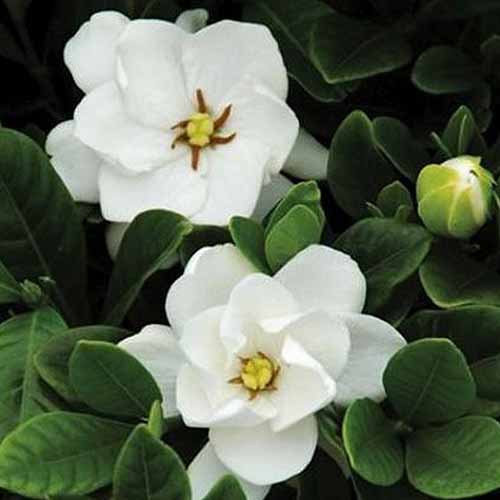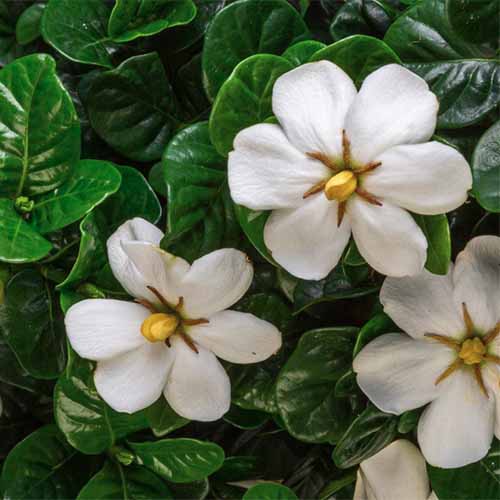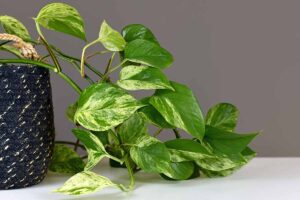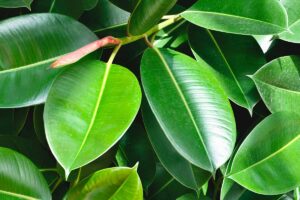Growing gardenias indoors serves as a small reminder that you can’t be all things to all people – or to all plants.
Flowering Gardenia jasminoides is a looker, with vibrant green foliage and creamy white or yellow blooms.
It’s striking when displayed as part of the decor in a sunroom or cramped apartment, and the flowers are elegant floating in a bowl of water as a centerpiece.
And the fragrance! Those blooms waft a sweet scent that conjures up summer nights and tropical breezes, even when there’s snow on the ground outside.
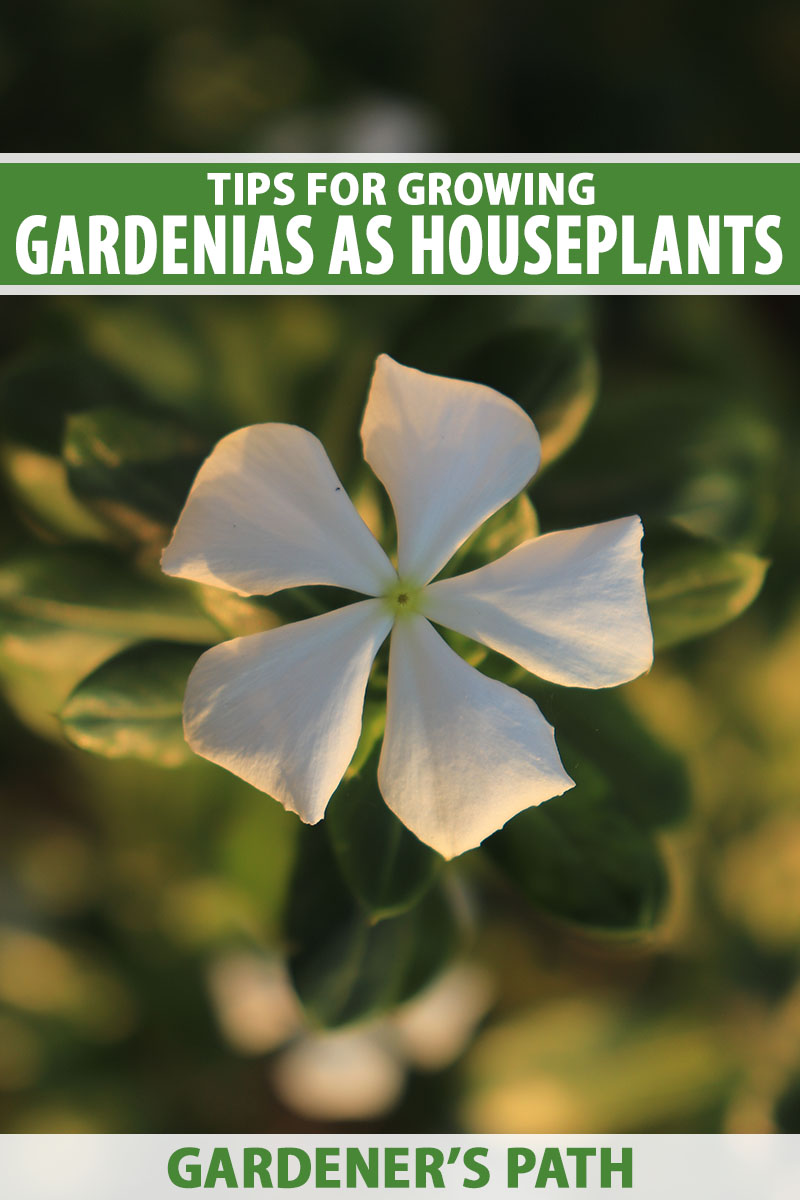
We link to vendors to help you find relevant products. If you buy from one of our links, we may earn a commission.
But this plant is not a good choice for anyone who’s looking for easy-care, low-light indoor greenery, or a houseplant that thrives on neglect.
Even experienced indoor gardeners find its need for constant humidity, frequent watering, and very specific light conditions challenging to cope with, not to mention its susceptibility to numerous insect pests like aphids, mites, and scale.
In other words, it’s not for everyone. But if you’re up for the challenge of meeting its needs indoors, you’ll be rewarded with uncommon beauty and fragrance.
When you opt to grow a gardenia cultivar that’s recommended for containers, you can improve your odds of success by following the techniques and heeding the precautions I’ll share here.
Here’s a rundown of the tips and conditions I’ll cover:
What You’ll Learn
Recommended Indoor Growing Conditions
Originating in the tropical regions of East Asia, the common gardenia delights in subtropical growing conditions in its native habitat.
It thrives in high humidity, and will bud and bloom in regions with temperatures that dip only to 55 to 60°F at night, and reach 70 to 75°F during the day when grown outdoors in the soil of a border or garden bed.
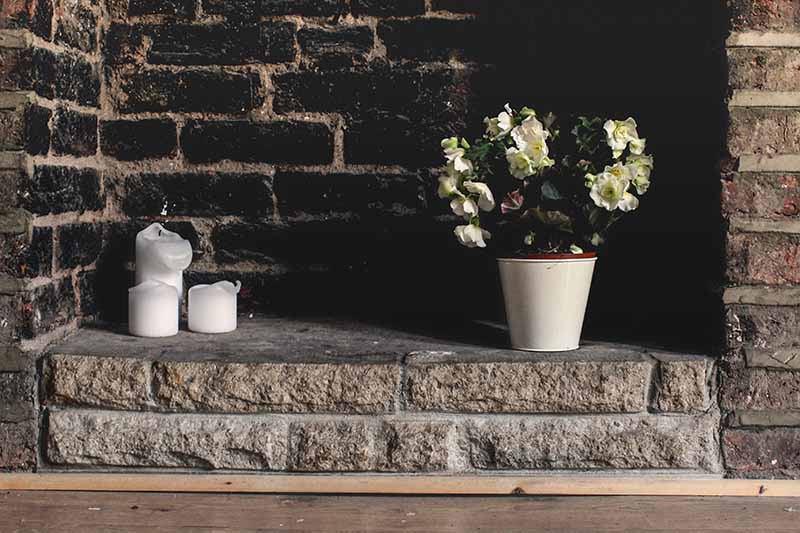
Outdoors, this species is fairly cold hardy and may be grown as a perennial in USDA Hardiness Zones 8 to 11.
It can live through freezing weather, but not when temperatures plunge below 10°F, though some of the newer hybrids can sustain temperatures as low as Zone 7’s 5°F, or even Zone 6b’s wintertime average low of -5°F.
Many gardeners in colder areas will grow G. jasminoides in containers and then bring them indoors to live out the colder months. You can learn how to overwinter gardenias successfully in our guide.
If you want to grow them strictly as houseplants, they have the same requirements as they would if they were grown outdoors, with a couple of add-ons to help them adjust to the limits of containers and the dry air inside your home.
Here are the demands you’ll need to meet:
Temperature
It’s ideal if your home thermostat is set to a cooler temperature at night, but you don’t want these plants to be subjected to constantly shifting air temperatures.
Place the pots somewhere with a relatively steady temperature that’s about 60°F at night, and 70 to 75°F during the day.
Avoid drafty areas and ones where the temperature varies by more than a couple of degrees during the daytime.
Light
This is one of the trickiest aspects of growing these beauties anywhere, not just inside. They need lots of bright light, about four or five hours of sunlight per day. But they also languish if they get too much direct sunlight.
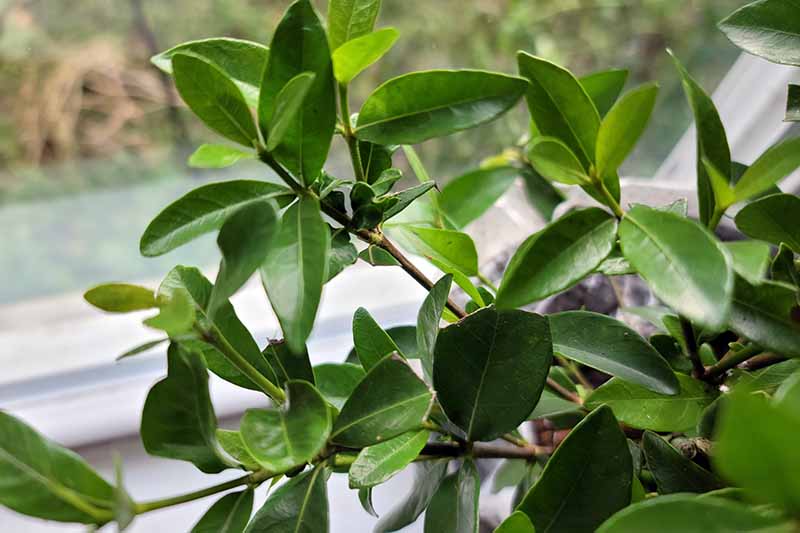
The ideal spot receives morning sun and afternoon shade. Indoors, you can provide that by placing the plants on or near a sunny windowsill that faces south or west.
Also consider augmenting the light with a grow light on a timer as needed, especially through the shorter days of winter.
Soil and Drainage
Drainage is the name of the game when you cultivate G. jasminoides indoors.
Be sure the pot you choose for planting has at least one drainage hole at the bottom, and provide a growing medium with plenty of added humus so it drains well and retains moisture.
If you have an ornamental container that doesn’t provide drainage, place one that does inside of it, with a saucer inserted between the ornamental and functional planters to catch excess water.
The soil should also have a pH of 5.0 to 6.0 for these acid-lovers. I recommend buying a prepackaged mix.

Dr. Earth Acid Lovers Premium Soil
One good choice is Dr. Earth Acid Lovers premium soil, available in 1.5-cubic-foot sacks from Amazon.
Humidity
Especially if you’re counting on them to develop buds and bloom, gardenias will need plenty of humidity indoors. Their preferred level is 50 percent!
It helps a bit to mist them with plain water, but you’ll also need to provide a tray with wet pebbles or moist sand positioned below each pot.
If your home has especially dry air when the heat is on in the winter, you may want to run a humidifier, too.
One handy option is the Pure Enrichment® MistAire™, an affordable model that shuts off automatically when it runs out of water.
It also has the capability to run for 25 hours.

Pure Enrichment® MistAire™ Humidifier
This model is available from Pure Enrichment via Amazon.
Care and Maintenance Tips
Once you’ve created your gardenia haven, you can move the houseplants in.
If you recently purchased a potted plant, you can usually use the container that it came in until it becomes so rootbound that you can see the roots protruding from the drainage holes at the bottom.
You’ll also need a waterproof saucer that’s at least an inch wider than the container, so you can catch and discard any excess when you water.
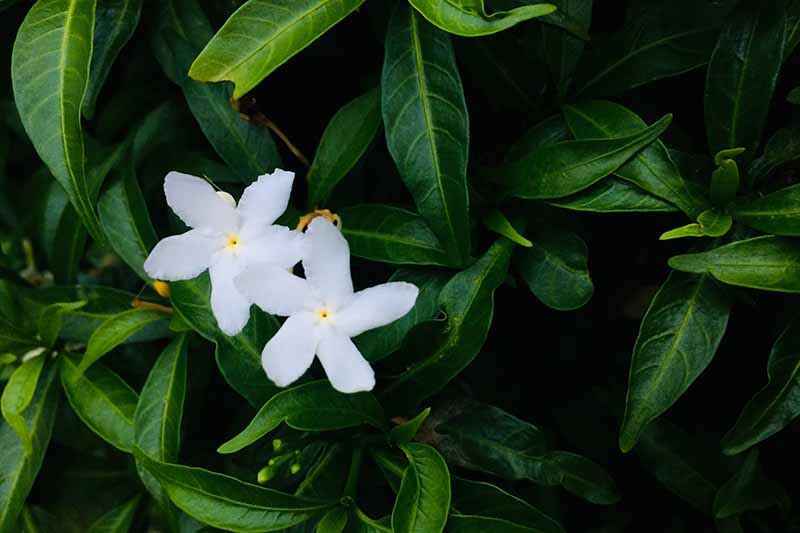
Most nursery containers are too plain to match the decor inside our homes, but be careful if you select a replacement pot or planter based on looks alone. Here are some additional pointers:
Gardenias don’t like to have their roots disturbed, so avoid repotting a plant that’s already comfortable in its current digs.
Instead, you can place the existing pot and its drainage tray inside a larger, more decorative container or cachepot without drainage holes, making sure that you can lift the inner container out easily to discard any excess water.
If you’re selecting a pot for a rooted cutting or transplant, it should be about four inches wider than the root ball and at least four inches deep.
Remember, the roots are fairly shallow and these houseplants bloom more readily if they’re a bit snug in their containers.
Avoid buying pots that have a “self-watering” reservoir at the bottom, or an attached saucer. You want to be able to leave the plant to drain after watering and then take the excess water away, as opposed to leaving the roots standing in it where they’re susceptible to root rot.
For large indoor gardenias that can no longer be contained inside a pot that’s smaller than one gallon in volume, it’s also prudent to find one that’s not too heavy.
Big clay or stone pots can be too heavy to move easily, which can hamper your efforts to fertilize, deadhead, or drain the excess in the saucer after you water.
For the bigger ones especially, I prefer lightweight pots made of plastic or metal, but only if they have drainage holes included. I also like to rest the inexpensive black plastic pots my gardenias arrive in on top of saucers, and then rest these inside an attractive lightweight basket.
On moving day, make sure to locate each potted G. jasminoides at least a couple of feet away from any other plants when you first bring it home so it won’t transmit or pick up any bugs, especially from any other houseplants that spent the summer outdoors.
If you’re used to houseplants that do just fine if they’re watered whenever it crosses your mind, that’s not going to work here. Without consistent moisture, gardenias will drop their leaves, so you’ll need to develop a regular watering schedule for this subtropical plant.
Let the soil dry down to two inches between waterings. And make sure to let the excess drain into a saucer that you’ve placed below each pot, to contain the water and so you can easily dispose of it. These specimens loathe wet feet and may develop root rot in oversaturated soil.
Also keep up with the fertilizer. Gardenias need a boost from an acidifying fertilizer on a regular schedule.
Follow the label directions to apply it in the proper amount and at the specified intervals.

Of course, one drawback to regular fertilizing with chemical-based products is the inevitable salt buildup in the soil that will result. Be sure to leach it every six months or so by saturating the soil and draining it a couple of times in succession, and discard the water after it flows through.
You’ll also want to clip any dead leaves or spent blooms on a regular basis, and trim an inch or two off the tips once a year or so to keep it shapely.
Finally, make sure to pay close attention to the condition of your plant so you can spot any indoor pests early on. A few that are common include aphids, mealybugs, scale, and whiteflies.
Reference our guide to growing gardenias for tips on preventing or eliminating these insect pests.
Cultivars to Select for Growing as Houseplants
I recommend smaller, hybrid varieties to grow as houseplants, but I’m not going to be heavy-handed with this advice.
If you are already attached to a certain larger cultivar, or have a source for cuttings from a mature shrub that’s not grafted onto disease-resistant stock, you can certainly grow these as houseplants, too.
Having said that, they’re not going to be as simple to care for inside as the dwarf or smaller cultivars that have been bred specifically for containers and small spaces.
There’s also a lot to be said for planting the most disease- and pest-resistant hybrids, to offset the many bugs and pathogens that may plague these flowering shrubs, though you’re less likely to encounter certain issues indoors.
If you haven’t already fallen for a different type of gardenia, try one of these smaller hybrids for indoor growing:
Buttons
Two-inch alabaster white flowers with “button” centers give this small-statured cultivar its name.
A broadleaf evergreen, this plant reaches two or three feet tall and spreads one to four feet.
‘Buttons’ is available in various sizes from Nature Hills Nursery.
Diamond Spire
An unusual dwarf variety, this cultivar produces daisy-shaped flowers and has foliage that forms a spiral around the branches. The leaves are pretty even when the plant isn’t blooming, with their glossy green surfaces and rounded shape.
While it grows to four feet tall, ‘Diamond Spire’ is still a preferred indoor cultivar, as long as you keep it pruned so it doesn’t get gangly.
‘Diamond Spire’ is available from the Southern Living Plant Collection in 2.5-quart containers from Home Depot.
Radicans
This is one of the tiniest varieties, growing just six to 12 inches tall. But it’s still fragrant, with the intoxicating scent that this species is known for wafting from its semi-double white blooms.
And the leathery, dark green, shiny leaves provide visual interest even when the plant isn’t blooming.
‘Radicans’ is available in quart-size containers from Nature Hills Nursery.
The Sweet Smell of Indoor Success
Even once they’re established, gardenia houseplants will never grow as easily as some other indoor favorites like pothos, aloe, or rubber tree plants.
On the other hand, those easy-care, no-green-thumb-required plants can’t produce elegant blooms or an alluring fragrance the way G. jasminoides does.
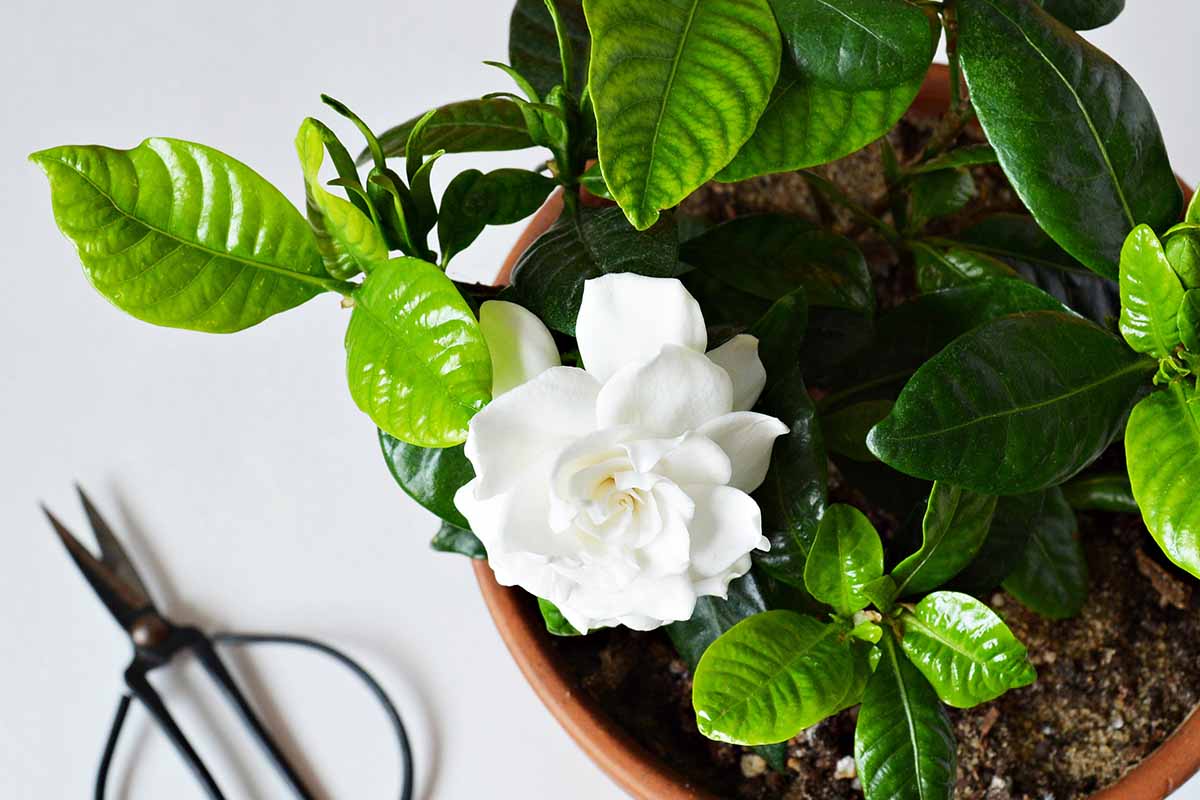
As with so many aspects of indoor gardening, whether you choose to grow these is simply a matter of what you want, and how much energy you’re willing to expend to make it happen.
My personal strategy is to focus the majority of my indoor efforts on growing reliable, no-fuss mother of millions succulents, philodendrons, and spider plants.
I like to have lots of green and soothing houseplants to fill my home, and choosing plants like these lets me grow dozens without that much maintenance required.
But I usually have at least one gardenia that lives on a windowsill in the guest bedroom. Growing just one requires more maintenance than 10 of the other houseplants I own, but one whiff of a bloom or glimpse of its glossy, dark green leaves, and I’m glad I made the effort.
What about you? Have you succeeded with growing this subtropical plant indoors? If you’re willing to share lessons learned or any questions, we’d be happy to have your input in the comments section below.
And if this coverage has piqued your interest in plants that bloom indoors, check out these flowering houseplant guides next:
